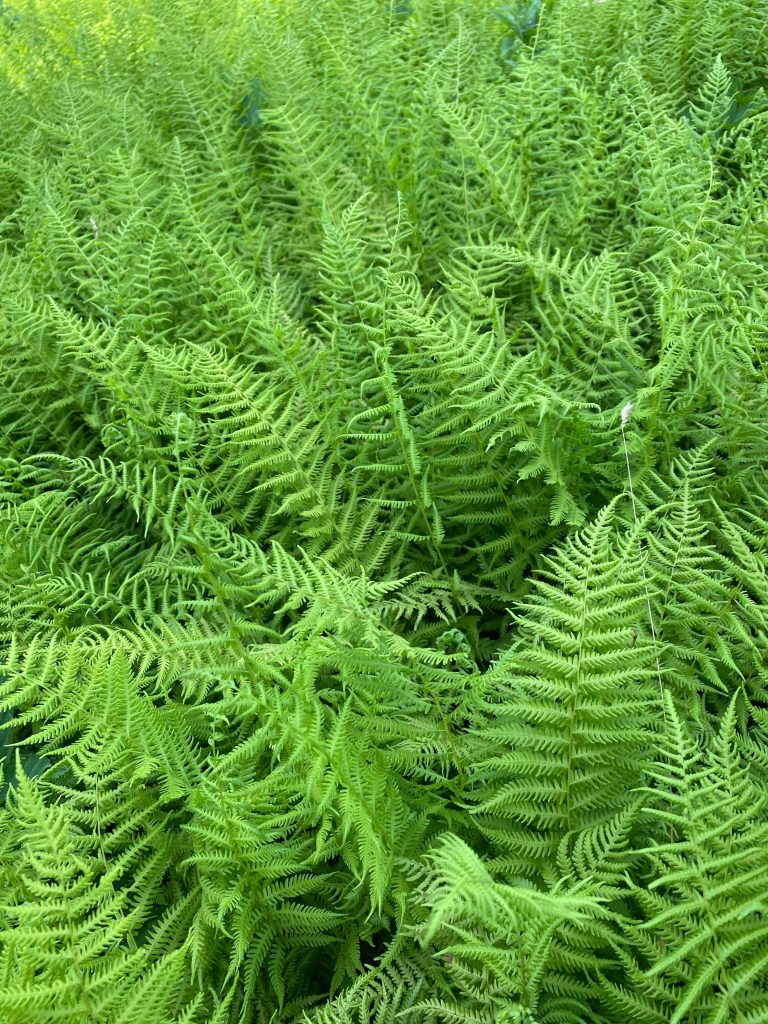Hay-scented Fern Sod for Landscaping

Introduction
Are you looking to transform your garden with a versatile native plant? Hay-scented Fern (Dennstaedtia punctilobula) is an excellent choice for your landscaping projects. This North American native plant offers a unique blend of beauty and practicality, making it suitable for any garden.
Imagine having delicate, lacy fronds that create a soft green carpet under your trees or along shaded paths. The natural spreading habit of Hay-scented Fern makes it an ideal ground cover option, while its distinctive hay-like fragrance adds an extra sensory experience to your outdoor area.
Your garden can also benefit from this fern’s positive impact on local biodiversity. As a native species, it:
- Provides shelter for beneficial insects
- Supports local wildlife populations
- Helps maintain ecological balance
- Requires minimal resources to thrive
In this guide, you’ll discover:
- The essential growing conditions for healthy ferns
- Creative ways to use them in landscaping
- Techniques for installation and maintenance
- Cost-effective solutions for ground cover
- Design ideas for shade and woodland gardens
Are you ready to enhance your landscape with this versatile native fern? Let’s explore how Hay-scented Fern can transform your garden into a sustainable and beautiful space.
Characteristics and Growing Conditions of Hay-scented Fern
Dennstaedtia punctilobula displays distinctive features that make it a standout choice for landscaping projects. The fern’s delicate fronds create a lacy, triangular shape, reaching heights of 1.5 to 2 feet with a spread of 2 to 3 feet. These yellowish-green fronds emerge in spring, creating a soft, feathery texture that adds visual interest to garden spaces.
The growth habit of Hay-scented Fern sets it apart from other fern species:
- Spreading Pattern: Develops extensive underground rhizome networks
- Colony Formation: Creates dense, carpet-like ground coverage
- Growth Rate: Fast-spreading, establishing quickly in suitable conditions
- Mature Size: Forms colonies spanning several feet in diameter
This hardy fern adapts to various growing conditions across USDA Zones 3-8. You’ll find it thrives in these soil conditions:
- Rich, humusy soils with good drainage
- Rocky, poor-quality soils
- Clay or sandy substrates
- Acidic to neutral pH levels
Moisture Requirements:
- Medium moisture levels
- Consistent soil dampness
- Tolerates occasional dry spells
- Avoid waterlogged conditions
The fern’s adaptability extends to light conditions, showing remarkable versatility:
- Part shade to full shade
- Morning sun with afternoon shade
- Dappled light under tree canopies
- Protection from harsh afternoon sunlight
Your Hay-scented Fern will establish robust root systems in locations that mimic its natural woodland habitat. The plant’s spreading tendencies through rhizomes make it particularly effective at soil stabilization and erosion control on slopes or challenging terrain. These characteristics, combined with its resilience to various environmental conditions, create a versatile option for different landscape designs.
Aesthetic Appeal and Functional Benefits in Landscaping with Hay-scented Fern
Hay-scented Fern brings dynamic visual interest to your garden throughout the seasons. The delicate, lacy fronds emerge in spring with a soft yellow-green hue, maturing into a rich emerald green during summer. As autumn approaches, these fronds transform into stunning golden yellow shades, creating a warm, inviting carpet beneath trees and along shaded pathways.
Visual Impact as Ground Cover
- Creates seamless, carpet-like coverage in shaded areas
- Fills gaps between larger plants and trees
- Softens harsh landscape edges
- Adds texture contrast against broad-leaved plants
- Provides year-round interest through changing colors
The fern’s natural spreading habit makes it an excellent choice for naturalizing spaces. You’ll find it particularly effective in:
- Woodland garden borders
- Under mature trees
- Along pathways
- Shaded slopes
- Between stepping stones
Low Maintenance Excellence
Hay-scented Fern proves remarkably self-sufficient once established. Its dense growth naturally suppresses weeds, reducing your garden maintenance time. The plant’s resilience shines through its ability to:
- Bounce back from seasonal damage
- Resist deer browsing
- Withstand varying moisture conditions
- Maintain healthy growth with minimal intervention
- Self-propagate through rhizomes
Natural Pest Management
The fern’s natural compounds deter many common garden pests, creating a protective barrier for nearby plants. This natural insect resistance reduces the need for chemical interventions, supporting a healthier garden ecosystem.
Design Integration
The fern’s versatile nature allows for creative landscape applications:
- Mass plantings for dramatic effect
- Mixed border plantings
- Natural transitions between garden zones
- Living mulch under shrubs
- Erosion control on slopes
These adaptable ferns blend seamlessly with other shade-loving perennials, creating layered, professional-looking landscape designs. Their reliable performance and aesthetic value make them an invaluable addition to any shade garden design strategy.
Applications in Landscape Design: Shade Gardens, Woodland Areas, Cottage Gardens
Hay-scented Fern thrives in multiple landscape settings, each offering unique design opportunities. Let’s explore the most effective ways to incorporate this versatile plant into different garden styles.
Shade Gardens
- Create layered plantings by positioning Hay-scented Fern beneath tall shade trees
- Pair with shade-loving companions like Hostas, Heucheras, and Astilbes
- Use as a natural border between pathways and deeper shade areas
- Plant in groups of 3-5 for initial coverage, allowing natural spread over time
Woodland Areas
- Let the fern naturalize between existing trees and shrubs
- Create drifts along woodland edges for a soft transition
- Mix with native wildflowers like Trillium and Wild Ginger
- Use as understory planting beneath mature trees to prevent soil erosion
Cottage Gardens
- Plant alongside traditional cottage flowers for textural contrast
- Edge informal garden paths with sweeping curves of fern
- Integrate into mixed borders with flowering perennials
- Fill shaded corners where other plants struggle to grow
Design Layout Examples
- Woodland Edge – Front layer: Hay-scented Fern (2′ spacing)
Middle layer: Native shrubs like Viburnum (6′ spacing)
Back layer: Existing canopy trees
- Shade Garden – Central focal point: Large boulder or garden art
Surrounding area: Hay-scented Fern in circular pattern
Accent plants: Japanese Forest Grass and Wood Ferns
- Cottage Garden Border – Irregular groupings of 5-7 ferns
Interspersed with flowering perennials Curved bed lines following natural terrain
Key Benefits of Wild Sods:
- Pre-established plant communities
- Native soil microorganisms intact
- Immediate ground coverage
- Reduced establishment time
- Natural resistance to local pests
Wild sods create instant ecosystems in your garden, bringing beneficial insects, native soil bacteria, and fungi that help Hay-scented Fern thrive. You’ll find these natural communities adapting faster to your landscape compared to individually planted specimens.
The harvesting process involves carefully removing sections of naturally growing fern communities, complete with their surrounding soil and companion plants. This method preserves the delicate relationships between plants and soil organisms.
These living mats create authentic woodland environments, supporting local wildlife and maintaining natural biodiversity. Wild sods represent a sustainable choice for gardeners seeking to recreate genuine forest floor conditions.
Using Hay-scented Fern Sod for Landscaping Projects: Installation Process and Cost-effectiveness
Hay-scented Fern sod offers a quick solution for establishing ground cover in your landscape. The installation process requires careful preparation and timing to ensure successful establishment.
Installation Steps:
- Clear the planting area of existing vegetation and debris
- Test soil pH (ideal range: 5.0-6.5)
- Till the soil to a depth of 6 inches
- Add organic matter to improve soil structure
- Level the area with a rake
- Lay sod pieces with edges touching
- Water thoroughly after installation
Maintenance Tips for Healthy Growth of Hay-scented Fern
Maintaining healthy Hay-scented Ferns requires specific care practices to ensure optimal growth and longevity. Here’s what you need to know about essential maintenance:
Watering Requirements
- Water deeply when soil feels dry 1 inch below surface
- Maintain consistent soil moisture without waterlogging
- Reduce watering during dormant winter months
- Apply mulch to retain moisture and regulate soil temperature
Fertilization Guidelines
- Apply balanced, water-soluble fertilizer (10-10-10) in early spring
- Feed once monthly during growing season
- Avoid over-fertilization – light applications work best
Pruning for Health and Aesthetics
- Remove dead or yellowing fronds at ground level
- Cut back old growth in late winter before new growth emerges
- Thin crowded areas to improve air circulation
- Trim damaged fronds throughout growing season
Natural Pest Management
- Inspect plants regularly for signs of slugs or caterpillars
- Create barriers using diatomaceous earth around plants
- Encourage beneficial insects like ladybugs and praying mantises
- Remove affected fronds immediately to prevent pest spread
Disease Prevention
- Space plants properly to prevent fungal issues
- Water at soil level to keep fronds dry
- Clean pruning tools between cuts
- Monitor for signs of crown rot in poorly-drained areas
Conclusion
Hay-scented Fern is a great example of using native plants for sustainable landscaping. Its ability to adapt, low maintenance needs, and natural spreading habits make it a fantastic option for creating beautiful gardens that also support local ecosystems.
By adding this hardy fern to your landscape design, you’ll enjoy several benefits:
- Creates stunning ground cover in challenging shaded areas
- Supports local wildlife and enhances biodiversity
- Requires minimal resources for maintenance
- Provides year-round visual interest
- Naturally controls soil erosion
Choosing to include Hay-scented Fern in your garden is a step towards eco-friendly gardening. To further enhance your landscape, consider combining it with other native plants such as Wild Ginger, Woodland Phlox, or Eastern Columbine. This will create a diverse and self-sustaining environment that pays tribute to the natural heritage of Eastern North America.
Remember: sustainable landscaping isn’t just about creating beautiful spaces—it’s about fostering healthy ecosystems that will thrive for generations to come.
More Pictures of our Hay-scented Fern (on some of the lands that Wild Sods of Maine harvests from)



